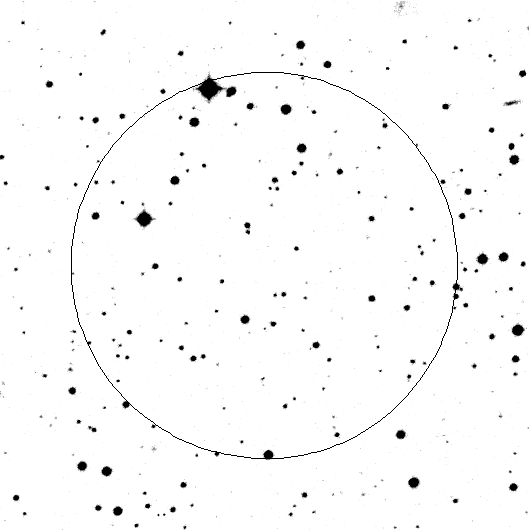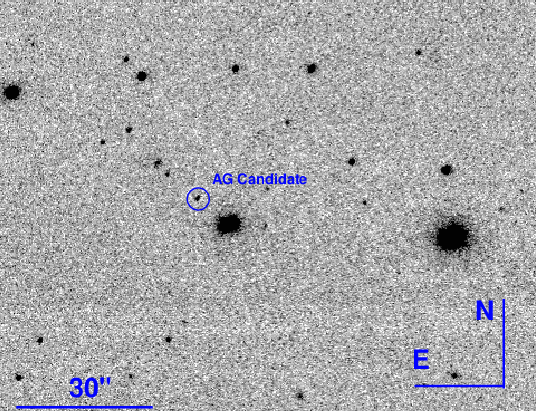- GCN/BACODINE POSITION NOTICE
TITLE: GCN/INTEGRAL NOTICE
NOTICE_DATE: Sat 30 Sep 06 09:05:02 UT
NOTICE_TYPE: INTEGRAL Wakeup
TRIGGER_NUM: 3503, Sub_Num: 0
GRB_RA: 304.4936d {+20h 17m 58s} (J2000),
304.5936d {+20h 18m 22s} (current),
303.7519d {+20h 15m 00s} (1950)
GRB_DEC: -23.6380d {-23d 38' 16"} (J2000),
-23.6167d {-23d 37' 00"} (current),
-23.7942d {-23d 47' 38"} (1950)
GRB_ERROR: 3.28 [arcmin, radius, statistical only]
GRB_INTEN: 8.07 [sigma]
GRB_TIME: 32664.25 SOD {09:04:24.25} UT
GRB_DATE: 14008 TJD; 273 DOY; 06/09/30
SC_RA: 295.87 [deg] (J2000)
SC_DEC: -26.80 [deg] (J2000)
SUN_POSTN: 186.49d {+12h 25m 58s} -2.81d {-02d 48' 18"}
SUN_DIST: 114.30 [deg] Sun_angle= -7.9 [hr] (East of Sun)
MOON_POSTN: 276.90d {+18h 27m 35s} -28.49d {-28d 29' 31"}
MOON_DIST: 25.30 [deg]
GAL_COORDS: 19.53,-28.91 [deg] galactic lon,lat of the burst
ECL_COORDS: 301.33, -3.87 [deg] ecliptic lon,lat of the burst
COMMENTS: INTEGRAL GRB Coordinates.
COMMENTS: Possibly real GRB event
- red DSS finding chart
ps-file

- GCN NOTICE
TITLE: GCN/INTEGRAL NOTICE
NOTICE_DATE: Sat 30 Sep 06 09:08:03 UT
NOTICE_TYPE: INTEGRAL Refined
TRIGGER_NUM: 3503, Sub_Num: 1
GRB_RA: 304.5179d {+20h 18m 04s} (J2000),
304.6178d {+20h 18m 28s} (current),
303.7762d {+20h 15m 06s} (1950)
GRB_DEC: -23.6266d {-23d 37' 35"} (J2000),
-23.6053d {-23d 36' 18"} (current),
-23.7829d {-23d 46' 57"} (1950)
GRB_ERROR: 3.17 [arcmin, radius, statistical only]
GRB_INTEN: 8.93 [sigma]
GRB_TIME: 32664.25 SOD {09:04:24.25} UT
GRB_DATE: 14008 TJD; 273 DOY; 06/09/30
SC_RA: 295.87 [deg] (J2000)
SC_DEC: -26.80 [deg] (J2000)
SUN_POSTN: 186.49d {+12h 25m 58s} -2.81d {-02d 48' 21"}
SUN_DIST: 114.32 [deg] Sun_angle= -7.9 [hr] (East of Sun)
MOON_POSTN: 276.93d {+18h 27m 43s} -28.49d {-28d 29' 24"}
MOON_DIST: 25.29 [deg]
GAL_COORDS: 19.55,-28.93 [deg] galactic lon,lat of the burst
ECL_COORDS: 301.36, -3.87 [deg] ecliptic lon,lat of the burst
COMMENTS: INTEGRAL GRB Coordinates.
COMMENTS: Possibly real GRB event
- GCN NOTICE
TITLE: GCN/INTEGRAL NOTICE
NOTICE_DATE: Sat 30 Sep 06 10:01:32 UT
NOTICE_TYPE: INTEGRAL Offline
TRIGGER_NUM: 3503, Sub_Num: 2
GRB_RA: 304.5363d {+20h 18m 09s} (J2000),
304.6362d {+20h 18m 33s} (current),
303.7946d {+20h 15m 11s} (1950)
GRB_DEC: -23.6251d {-23d 37' 29"} (J2000),
-23.6038d {-23d 36' 13"} (current),
-23.7815d {-23d 46' 52"} (1950)
GRB_ERROR: 2.50 [arcmin, radius, statistical only]
GRB_INTEN: 8.93 [sigma]
GRB_TIME: 32664.25 SOD {09:04:24.25} UT
GRB_DATE: 14008 TJD; 273 DOY; 06/09/30
SC_RA: 295.87 [deg] (J2000)
SC_DEC: -26.80 [deg] (J2000)
SUN_POSTN: 186.53d {+12h 26m 06s} -2.82d {-02d 49' 13"}
SUN_DIST: 114.30 [deg] Sun_angle= -7.9 [hr] (East of Sun)
MOON_POSTN: 277.48d {+18h 29m 56s} -28.46d {-28d 27' 19"}
MOON_DIST: 24.82 [deg]
GAL_COORDS: 19.56,-28.94 [deg] galactic lon,lat of the burst
ECL_COORDS: 301.37, -3.87 [deg] ecliptic lon,lat of the burst
COMMENTS: INTEGRAL GRB Coordinates.
COMMENTS: refined_coordinates_after_offline_analysis
- GCN Circular #5665
D.Gotz (CEA, Saclay), S.Mereghetti, A.Paizis (IASF-Milano), M.Lazos,
N.Mowlavi, M. Beck (ISDC, Versoix), and J. Borkowski (CAMK, Torun) on
behalf of the IBAS Localization Team report:
An X-ray rich GRB lasting about 20 s has been detected by IBAS in
IBIS/ISGRI data at 09:04:09 UT on September 30, 2006.
The coordinates (J2000) are:
RA: 304.5363 [degrees],
DEC: -23.6253
with an uncertainty of 2.5 arcmin (90% c.l.).
The peak flux in the 20-200 keV is 0.3 ph/cmq/s (2.2x10e-8 erg/cmq/s) over
1 s integration time and the fluence in the same energy range is 2.5x10e-7
erg/cmq
We note that the faint ROSAT X-ray source 1RXS J201811.2-233536 is
contained in the error region. Its RASS count rate of 0.03 counts/s
corresponds to about 2x10e-13 erg/cmq/s
A plot of the light curve will be posted at
http://ibas.mi.iasf.cnr.it/IBAS_Results.html
This message can be cited.
- GCN Circular #5666
H. Swan (U. Michigan), W. Rujopakarn (U. Arizona), S.A. Yost (U.
Michigan), E.S. Rykoff (U. Michigan), B. E. Schaefer (Louisiana
State), report on behalf of the ROTSE collaboration:
ROTSE-IIIa, located at Siding Spring Observatory, Australia, responded
to GRB 060930 (Integral trigger 3503), producing images beginning 6.3
s after the GCN notice time. An automated response took the first
image at 09:05:08.3 UT, 44.1 s after the burst, under fair conditions.
We took 10 5-sec, 10 20-sec and 80 60-sec exposures. These unfiltered
images are calibrated relative to USNO A2.0 (R).
Comparison to the DSS (second epoch) reveals no new sources within the
3-sigma error circle, for both single images and coadding into sets of
10. Individual images have limiting magnitudes ranging from 15.8-17.1;
we set the following specific limits.
start UT end UT t_exp(s) mlim t_start-tGRB(s) Coadd?
--------------------------------------------------------------------
09:05:08.3 09:05:13.3 5 15.8 44.1 N
09:05:08.3 09:07:44.3 156 17.1 44.1 Y
- GCN Circular #5669
M.Zhai, L.P. Xin, Y.L. Qiu, J.Y. Wei, J.Y. Hu, J.S. Deng
Y. Urata and W.K. Zheng on behalf of EAFON report:
We have imaged the field of GRB 060930 with the TNT 0.8m telescope
at Xinglong Observatory.Observations started about 2.74 hours after the
burst under bad condition (cloudy and high airmass). in our combined
6*10 minutesR band image, we do not detect any new source down to
~17.25 with mean time 3.55 hours after the burst derived from USNO A2.0
This message may be cited.
- GCN Circular #5670
C. Guidorzi (Univ Bicocca & INAF-OAB), D. Bersier (Liverpool JMU),
C.G. Mundell, I.A. Steele, A. Melandri, A. Gomboc
(University of Ljubljana), R.J. Smith, A. Monfardini, D. Carter,
S. Kobayashi, M. Bode (Liverpool JMU), E. Rol, P. O'Brien,
N. Bannister (Leicester) report:
"The 2m Faulkes Telescope South (Siding Spring, Australia) automatically
reacted to the INTEGRAL burst GRB 060930 (Gotz et al., GCN Circ. 5665)
and began observing 1.98 minutes after the burst trigger time.
From a stacked 6x10s R-band image (from 1.98 min to 4.97 min after the
burst) with a FOV of 4.75' x 4.75' centred on the first INTEGRAL error
circle (RA=20:17:58; Dec=-23:38:16, J2000) we do not detect any
object not present on the DSS, down to R~19.5 (calibrated with the
USNOB catalogue). Furthermore we do not detect any variable object
down to the same limit."
- GCN Circular #5682
A. de Ugarte Postigo, M. Jelinek, A.J. Castro-Tirado, =20
J.Gorosabel (IAA-CSIC Granada), N. Pinilla-Alonso (TNG La Palma)
J. de Le=C3=B3n Cruz (IAC Tenerife), J. Licandro (ING-IAC)
on behalf of a larger collaboration report:
We have observed the field of the GRB 060930 detected by INTEGRAL=20
(Gotz et al., GCN 5665) with the 3.5m Telescopio Nazionale Galileo=20
(+NICS) at La Palma in the JHK bands on 30 Sep 2006 (from 20:30 to=20
20:51 UT) and revisited the field in H band on 1 Oct 2006 (from=20
20:37 to 20:51 UT; i.e. 11.5 hr and 35.5 hr respectively after the=20
onset of the gamma-ray event).
The NICS frames cover the central 80% of the INTEGRAL/IBIS error=20
box (2.5' radius). We detect a variable, stationary object at the=20
following coordinates (J2000):
RA =3D 20:18:11.51, Dec =3D -23:37:19.6
with an astrometric error of 0.5".
In the first epoch the source is detected in all 3 bands and has=20
an H band magnitude of ~18.2. In the second H band epoch it has=20
faded by about 1 magnitude. This would imply a decay index of=20
alpha -0.9 +/- 0.2 .
For this object we obtain (Js-K)=3D1.10+/-0.22, consistent with the
near-IR colour expected for a GRB afterglow (Gorosabel et al. 2002,=20
A&A, 384, 11).
A finding chart is available at:
http://www.iaa.es/~deugarte/GRBs/060930/grb060930.gif
This message is quotable.

- GCN Circular #5701
A. de Ugarte Postigo, M. Jelinek, A.J. Castro-Tirado,
J. Gorosabel (IAA-CSIC Granada)
on behalf of a larger collaboration report:
"We have reobserved the field of GRB 060930 (GCNC 5665)
on a third epoch. This time we obtained frames with the
3.5m Calar Alto telescope in the H-band on Oct. 5.81 UT.
The magnitude of the suspected afterglow candidate that
we reported in GCNC 5682 is consistent with the one measured
on the first epoch and we believe that the data taken on
the second epoch (Oct 1.86 UT) were severely affected due
to the presence of the Moon four degrees away.
We thus conclude that the object reported in GCNC 5682
is not the near-IR afterglow to GRB 060930. A search for
variability of the faintest near-IR sources within the INTEGRAL
error box is under way.
We acknowledge Heather F. Swan for also independently
pointing out this to us by means of AEOS data."
![]() Previous IAU Circulars
Previous IAU Circulars 
